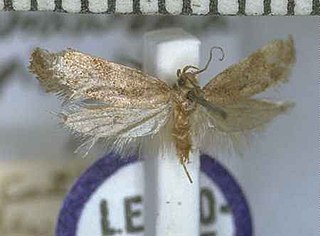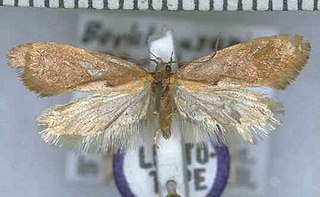
Eulamprotes is a genus of moths in the family Gelechiidae.
Eulamprotes nigromaculella is a moth of the family Gelechiidae. It is found in Spain, France, Italy, Greece, Corsica, Sardinia, Sicily, Crete, Cyprus and Ukraine.
Eulamprotes helotella is a moth of the family Gelechiidae. It is found in Spain, Portugal, France, Italy, Greece, Corsica, Sardinia, and Crete. It is also found in North Africa.
Rhopalosetia is a monotypic moth genus in the family Copromorphidae. Its only species, Rhopalosetia phlyctaenopa, is found in French Guiana. Both the genus and species were first described by Edward Meyrick in 1926.
Dichomeris syringota is a moth in the family Gelechiidae. It was described by Edward Meyrick in 1926. It is found in Peru.
Hypatima agriogramma is a moth in the family Gelechiidae. It was described by Edward Meyrick in 1926. It is found on Borneo.

Anomologinae is a subfamily of moths in the family Gelechiidae.
Stomopteryx frivola is a moth of the family Gelechiidae. It was described by Edward Meyrick in 1926. It is found in South Africa.
Megacraspedus squalida is a moth of the family Gelechiidae. It was described by Edward Meyrick in 1926. It is found in Spain.
Eulamprotes ochricapilla is a moth of the family Gelechiidae. It was described by Rebel in 1903. It is found in France, Italy, the Czech Republic, Slovakia and Romania.
Tisis polemarcha is a moth in the family Lecithoceridae. It was described by Edward Meyrick in 1926. It is found on Borneo and Sabah.
Cophomantella alphanozoma is a moth in the family Lecithoceridae. It was described by Edward Meyrick in 1926. It is known from Sierra Leone and Uganda.

Tinea belonota is a species of moth in the family Tineidae. It is endemic to New Zealand. It is classified as not threatened by the Department of Conservation.

Tingena anaema is a species of moth in the family Oecophoridae. It is endemic to New Zealand and has been collected at Lake Wakatipu, Invercargill and Stewart Island / Rakiura. The adults of the species are on the wing in December.

Tingena apanthes is a species of moth in the family Oecophoridae. It is endemic to New Zealand and found on the North Island. The adults are on the wing from October to December. It appears associated with Leptospermum species and it has been hypothesised that the appearance of the adults of this species imitates faded Leptospermum leaves.

Tingena epimylia is a species of moth in the family Oecophoridae. It is endemic to New Zealand and is found in both the North and the South Islands. This species is similar in appearance to Tingena contextella as it too has a mottled appearance, but T. epimylia can be distinguished as it is smaller in size, slightly narrower wings, and has a more grey appearance and a grey head. This species inhabits native beech forests at altitudes between 1500 and 2000 ft and in particular has an affinity for Nothofagus solandri.

Tingena hemimochla is a species of moth in the family Oecophoridae. It is endemic to New Zealand and has been observed in the North Island. Adults of this species are on the wing from December until March.

Tingena horaea is a species of moth in the family Oecophoridae. It is endemic to New Zealand and have been observed in both the North and South Islands. The adults are on the wing in January.

Tingena letharga is a species of moth in the family Oecophoridae. It is endemic to New Zealand and has been observed in Otago. Adults are on the wing in December and January.

Tingena perichlora is a species of moth in the family Oecophoridae. It is endemic to New Zealand and has been observed in the southern parts of the South Island. This species appears to inhabit manuka scrub. Adults of this species are on the wing from October to January.








